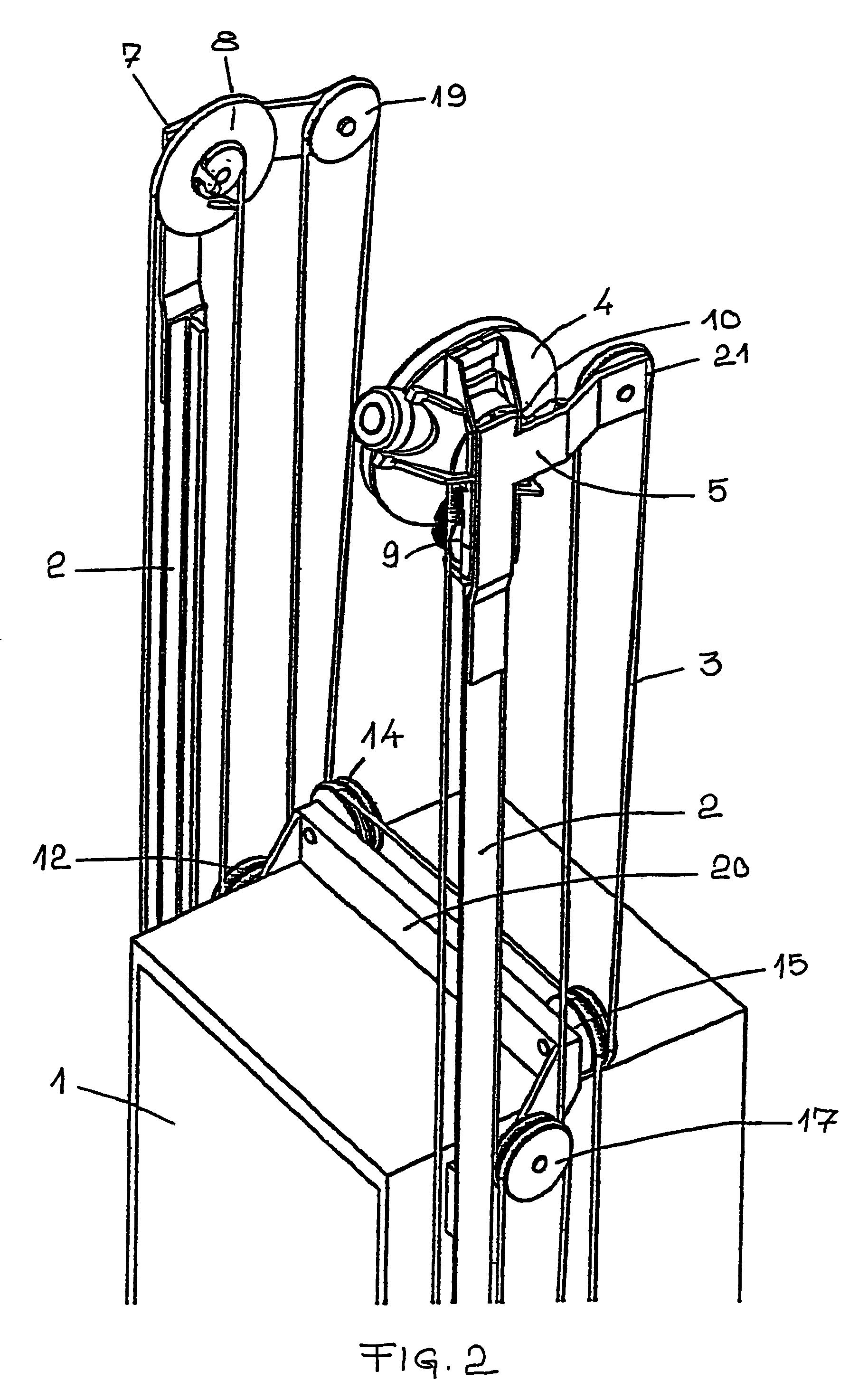In these basically good elevator solutions, the space and placement of the hoisting function limits the freedom of choice in elevator lay-out solutions.
The arrangements for the passage of the hoisting ropes require space.
The space required by the elevator car itself on its track, and likewise the space needed for the counterweight, can not be easily reduced, at least at a reasonable cost and without compromising on the performance and quality of operation of the elevator.
In a traction sheave elevator without
machine room, installing the hoisting machine in the elevator shaft, especially in the case of solutions with machine above, is often difficult because the hoisting machine is a fairly heavy and large object.
Especially in the case of elevators for larger loads, speeds and / or hoisting heights, the size and weight of the machine are a problem in respect of installation, even so much so that the required machine size and weight have in practice limited the scope of application of the concept of elevator without machine room, or at least retarded the introduction of said concept in larger elevators.
The space available in the elevator shaft in elevator modernization projects has often limited the scope of application of the concept of elevator without machine room.
Often, especially in the cases of modernization or replacement of hydraulic elevators, it has not been practical to apply a roped elevator solution without machine room, due to insufficient space in the elevator shaft especially in a situation where no counterweight has been used in the hydraulic elevator solution to be modernized / replaced.
The drawbacks of elevators provided with a counterweight include the cost of the counterweight and the space required for the counterweight in the elevator shaft.
Drum-driven elevators, which at present are quite seldom installed, have the disadvantages of heavy and complicated hoisting machines and their high power and / or torque requirements.
Prior-art elevator solutions without counterweight are exotic and no appropriate solutions are known.
So far, it has not been technically or economically reasonable to make elevators without counterweight.
In prior-art elevator solutions without counterweight, the tensioning of the hoisting
rope is implemented using a weight or spring, and that is not an attractive approach to implementing the tensioning of the hoisting
rope.
Another problem with elevators without counterweight, when long ropes are used e.g. due to a large hoisting height or large suspension ratios used, is the compensation of
rope elongations and at the same time, due to rope elongations, the friction between the traction sheave and the hoisting ropes is insufficient for the operation of the elevator.
On the other hand, hydraulic elevators have many drawbacks related to their lifting principle and use of oil.
Hydraulic elevators have a
high energy consumption, a possible oil leakage from the equipment is an
environmental hazard, the periodically required oil change involves a high cost, even an elevator installation in good condition causes olfactory disadvantages as small amounts of oil escape into the elevator shaft or machine room and from there further to other parts of the building and into the environment and so on.
Due to the shaft efficiency of a hydraulic elevator, modernization of the elevator by replacing it with another type of elevator that would allow the drawbacks of the hydraulic elevator to be avoided but would necessitate the use of a smaller elevator car is not an attractive solution to the owner of the elevator.
Hydraulic elevators also have small machine spaces, which may be located at a distance from the elevator shaft, making it difficult to change the elevator type.
Later, both
user needs and the practical requirements of the buildings have changed in many cases and an old traction sheave elevator may have become insufficient in respect of size of the elevator car or in other respects.
For example, older elevators of a rather small size are not necessarily suited for transporting perambulators or roller chairs.
On the other hand, in older buildings that have been converted from residential use to office or other use, the originally installed smaller elevator is no longer sufficient in capacity.
As is known, increasing the size of such a traction sheave elevator is practically impossible because the elevator car and counterweight already fill the cross-sectional area of the elevator shaft and the car can not be reasonably enlarged.
In practice, a rope having a wire strength of about 2100 N / mm2 is chosen rather than a rope in which the wire strength is very much greater, e.g. 3000 N / mm2, because a stronger wire is generally also more expensive and its quality can not necessarily be as easily standardized as the quality of a less strong rope.
 Login to View More
Login to View More  Login to View More
Login to View More 


